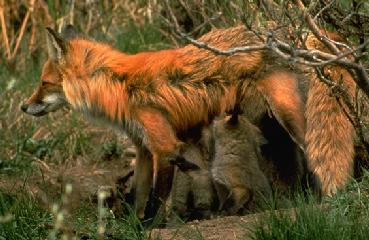Reproduction
As seen in all animal species the red fox must reproduce in order
to sustain its population. The average age of sexual maturity for
foxes is 10 months which is when the red fox generally mates (Rue,
1969). The female fox, or vixen, comes into heat only once a year
and mating normally occurs in early January (National Geographic).
The female fox is only in heat for an average of three days and
this is when the copulation ensues (Rue, 1969). As the red foxes get
closer to mating they will become more verbal and active, producing
loud barks and yelps (Harris, 1986). As the vixen gets closer to
estrus, the male fox, also known as the dog fox, will spend more and
more time with her following her around (Harris, 2009). Once the
time of copulation does come, the male fox will raise his tail high
in order to show the female fox that he is ready (Harris, 1986).
The male fox will nuzzle or paw at the vixen until she allows the
dog fox to mount and complete copulation (Storm et al., 1976). If
the vixen rejects the male fox’s advances the vixen may snap or
snarl at the dog fox (Harris, 1986). Since the red fox is primarily
a monogamous animal it only has one mate (Rue, 1969). This mate
will stay and help care for the kits once they are born.

During the pregnancy, normally lasting 52 days, the red fox will investigate and clean out a den site for her unborn kits (Rue, 1969). The female fox becomes inactive in her final days of pregnancy awaiting the birth of her offspring (National Geographic). When the red fox gives birth to her kits, normally around late March, the babies are blind and covered in a fine-textured grey fur (National Geographic). The average litter size is 6 kits (Harris, 1986). For the first two weeks of the foxes’ lives the mother will not leave their side, this is because the kits are unable to maintain their own body heat (Harris, 1986). At this time the vixen and her kits are unable to procure food so the dog fox will bring food directly to them (Rue, 1969). After two weeks the kits will be able to open their eyes, but their eyesight is very poor, during this time they will also slowly develop the ability to crawl (Storm et al., 1976). Around four weeks of age the kits will begin to emerge out of the den but will stay close for protection (Harris, 1986).
The red fox is an extremely nurturing animal and has been
known to form “fox families” (Harris, 1986). These “families” are
not necessarily related to one another. Typically these “families”
are smaller than an average wolf pack and have been known to average
around five or six adults at one time (Harris, 1986).
The fox kits live off of their mother’s milk for approximately four to six weeks before moving onto solid food, they begin by consuming regurgitated food from the vixen and slowly transition to small birds or rabbit meat (Harris, 1986). For the first few months the food will be brought to the kits directly from the adults (Rue, 1969). Shortly after this the kits will be forced to find their own food and they will begin to become less dependent on the adult foxes. Kits will begin practicing hunting by catching and consuming insects, helping transition them into adulthood (Harris, 1986).
To learn more
about who the red fox interacts with, visit the
interactions page!

